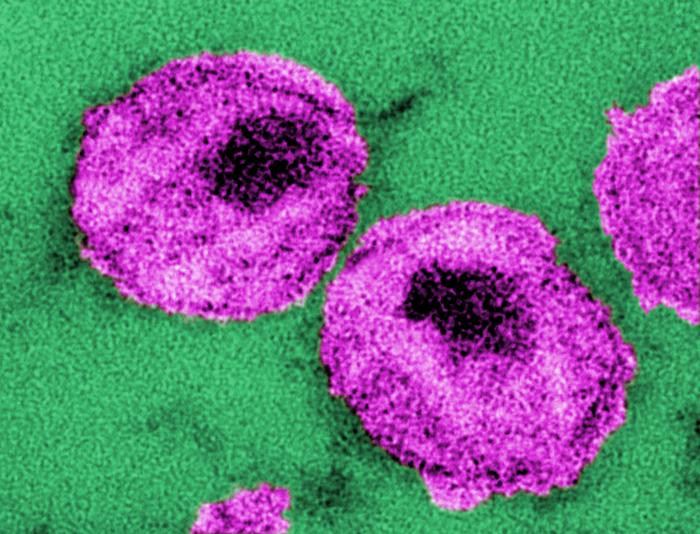A team of scientists at the Salk Institute and Rutgers University has determined the molecular structure of HIV Pol, a protein that plays a key role in the late stages of HIV replication, the process through which the virus propagates itself and spreads through the body. Importantly, determining the molecule’s structure helps answer longstanding questions about how the protein breaks itself apart to advance the replication process.
Understanding how HIV replicates within cells is key to developing new treatments that could help the nearly 40 million people globally who live with HIV. The new discovery reveals a new vulnerability in the virus that could be targeted with drugs. “Structure informs function, and the insights we gained from visualizing the molecular architecture of Pol give us a new understanding of the mechanism by which HIV replicates,” stated Dmitry Lyumkis, PhD, assistant professor in the Laboratory of Genetics and Hearst Foundation Developmental Chair at Salk. Lyumkis is co-senior author of the team’s published paper in Science, titled “Cryo-EM structure of HIV-1 Pol polyprotein provides insights into virion maturation.”
“Many of the gene products of RNA viruses are initially translated as precursor polyproteins that are subsequently cleaved to yield mature proteins that play either structural or enzymatic roles,” the investigators explained. Scientists previously knew that the HIV Pol polyprotein breaks into three enzymes—a protease (PR), a reverse transcriptase (RT) and an integrase (IN)—that work together to assemble the mature form of the virus.
The protease plays a critical role in initiating this process by chopping up the molecule to separate the other components. However, it was previously unknown how the protease itself breaks free, first from the larger polyprotein HIV Gag-Pol and then from HIV Pol, to accomplish this task. “In HIV-1, the structural proteins are translated initially as part
of Gag polyprotein, while the enzymes that enable the virus to multiply and spread are synthesized as part of the Gag-Pol precursor polyproteins,” the investigators noted in their published paper. “Both polyproteins are cleaved by the viral protease (PR), which is synthesized as part of Gag-Pol, during maturation.”
However, they further noted, relatively little is known about the molecular organization of the Pol portion of the Gag-Pol polyprotein or the immature forms of the viral enzymes. “This is due, at least in part, to the absence of systems that can be used to efficiently produce and purify large amounts of the HIV-1 Gag-Pol or Pol polyproteins for structural and other biophysical studies.”
The newly reported work suggests that the protease initiates the process by self-cleaving or cutting itself free from the rest of the molecule, aided by reverse transcriptase and, possibly, integrase.
For their study the team used cryogenic electron microscopy, an imaging technique to which Lyumkis has made important contributions, to reveal the three-dimensional structure of the HIV pol protein molecule. This led to the discovery that Pol is a dimer, meaning that it is formed by two proteins bound together. The finding was a surprise because other similar viral proteins are single-protein assemblies.
“The first challenge was producing a stable version of HIV Pol so the structure could be analyzed, which had never previously been reported,” says co-first author Jerry Joe Harrison, phD, senior lecturer at the University of Ghana. The authors noted, “We developed a system to produce stable HIV-1 Pol and determined its cryo–electron microscopy structure.” Co-senior author Eddy Arnold, PhD, board of governors professor and distinguished professor in the Center for Advanced Biotechnology and Medicine at Rutgers University, noted, “This was a key missing piece of the HIV structural puzzle.”
The group showed that in this two-sided structure, the protease component of Pol is “loosely tethered” to the reverse transcriptase component in a binding configuration that keeps the protease slightly flexible. “It’s holding the protease at arm’s length, loosely, and we believe that gives the protease a little bit of movement, which in turn allows it to initiate the cutting of polyproteins that is a prerequisite for viral maturation,” said co-first author Dario Passos, PhD, a former researcher in Lyumkis’ lab at Salk. “Current HIV treatments include multiple classes of inhibitors for all three enzymes, and the discovery also reveals a new vulnerability that could be targeted with drugs.”
“It was known (but not understood) that there is a coupling between these enzymes before HIV Pol breaks apart,” Commented Arnold. “Visualizing the HIV Pol structure explains the basis for this complex mechanism.”
The authors concluded in their paper, “ … our cryo-EM structure indicates that PR can form dimers while part of Pol … Together, our results show how HIV-1 maturation leverages the dimerization interface in the RT portion of Pol to regulate the maturation of polyprotein precursors.”
The authors say the discovery opens the door for important follow-up research, including studies of the structure of the larger and more complex polyprotein Gag-Pol, also involved in viral assembly, as well as taking a closer look at the role of integrase in assembling the mature form of the HIV virus during replication.


